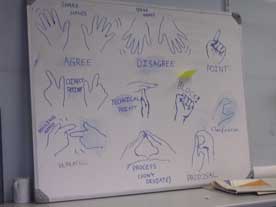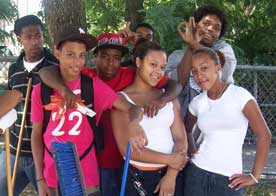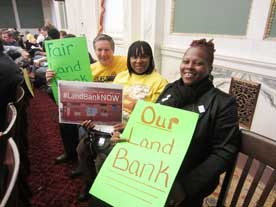A core principle for most community land trusts and other community-based housing organizations is resident and community empowerment. How do we foster this? One way is to welcome all voices at the table where decisions are made. And one of the most powerful ways to embrace diversity of opinion is to make decisions by consensus.
During my 18-year tenure as the executive director of OPAL Community Land Trust, and as the board president of numerous other organizations, I have used consensus and consensus-based decision-making with great success and seen it lead to thoughtful and durable decisions. I have learned the ingredients needed for consensus to work and also identified situations where consensus is likely to fail.
What Is Consensus?
Consensus decision making is a process by which a group reaches unity of consent on a decision. Every member of the group need not agree with the decision, but they all make an agreement to stand behind the decision, because each member of the group believes it is the best possible decision for the group at the time.
Why Consensus?
I was first introduced to the practice of consensus when I joined the board of OPAL (Of People And Land) in 1994. OPAL’s founders hard-wired consensus into the organizational DNA by making consensus decision-making a governing requirement. The bylaws eloquently state the principle behind this requirement: “Built into this consensus process are the assumptions that we are all trustworthy, that we are all equal, and that each of us has part of the truth and no one has all of it.”
OPAL’s founders chose consensus to ensure that the residents—the organization’s constituents—had an equitable voice in the boardroom. One-third of the trustees are representatives of the low-income community. It is not uncommon for community-based organizations to have constituent board members, but it is all too common for the constituent members to be tokens who don’t fully participate because they aren’t trusted, or they don’t trust that their ideas will be treated with respect.
Boardrooms in America are filled with people who learn how to dominate in order to get their way. Constituents of community-based organizations, on the other hand, have rarely served on a board of directors. They are not accustomed to sitting at the table where power resides, and may feel intimidated by people who believe they are more capable, or whom the constituent views as more experienced.
That is why consensus is such a powerful tool. Consensus creates a framework where every voice is valued and everyone has the opportunity to listen deeply to each other. We learn that everyone at the table who is prepared and present has something to offer toward the resolution.
How Does Consensus Work?
Consensus works when the following ingredients are in place:
- Each member of the group is committed to the value and believes it will work. You trust the other members of the group, and believe there is a solution. You put the good of the group or organization above your own self-interest.
Members who are new to the process need training. The training is different for people who have run Fortune 500 companies than it is for people who have never served on a board of directors, but all benefit from learning why consensus matters and how it works. - Each member engages constructively. You show up for each meeting prepared, listen deeply, and remain open to new ideas or perspectives. You speak politely, constructively, and truthfully from your personal experience. And you ask for and receive the information you need to make an informed choice.
- The facilitator provides equitable access and sufficient time to deliberate, poses questions that drive toward resolution, and documents each stage and the final decision in writing. An effective facilitator is a key ingredient. Each member of a group may help with the tasks identified for the facilitator, but it is important to have one person designated in the role. This person maintains the tone of civility, assures that no one takes a disproportionate amount of air time, gauges when it is time to allow for organic conversation rather than a roll-call check in, determines when it is time to pause, summarizes information that group members have stated they need, and poses questions in a manner that keeps the group focused. Complex issues need to be broken down into parts. The facilitator helps to arrange those parts in an order that leads toward a final resolution. Capturing agreements and stages of agreements in writing is critical for clarity.
Most of the process for engaging consensus decision-making could be employed by any organization, whether it formally operates by consensus or not. It generally follows these steps: define the topic or issue; state issues, concerns, or considerations; propose alternatives; and explore solutions. An organization that uses consensus may make many routine decisions with a simple voice vote, but when the decision is more complex, consensus is best achieved by following these steps:
First, the meeting facilitator (for example the board chair or president) sets aside sufficient time for the issue to be discussed at several consecutive meetings. A designated person—commonly the executive director—prepares a written brief containing background, analysis, and a recommendation or options. The first time an issue is discussed the facilitator frames the issue and does a roll call, asking each member of the group to state their position. Sometimes consensus is achieved right away.
Roll Call Process:
- It is important for the roll call to occur in an orderly fashion and for the group members to understand the order. A common approach is for the person to the left or right to speak next. With order, you know when it will be your turn, and this makes it easier to listen.
- One person speaks at a time. This is a firm rule. No interrupting. Strict adherence to this rule fosters confidence to speak. And it helps people who are skilled interrupters abide by their promise to listen. As a listener, you may take notes to remind yourself of what you want to say.
- Perhaps when your turn arrives, you don’t want to speak. Maybe what you wanted to say has already been said, and it does not need to be repeated. You may pass. Maybe you want more time, so you may ask the facilitator to come back to you after everyone else has spoken.
- Each person should be allowed a similar amount of time to speak, even if they don’t use all the allotted time. The facilitator could set a maximum time for each person, or manage the allocation of time in a less formal way.
For more difficult issues, it may take multiple meetings or multiple rounds of roll calls to reach consensus. Perhaps more research is needed, or the topic is sent back to the relevant committee for further shaping. The facilitator may clarify the process by segmenting the issue, again using the roll call method for each step.
The roll call cycle is repeated until either a consensus is reached, or (rarely) one or more members are not aligned with the rest of the group.
When consensus can’t be reached is where consensus decision-making process diverges most sharply from majority vote. Under majority vote, at this point the discussion would be closed and the group would vote.
Under consensus, when there are dissenting individualism the group has four options for how to proceed:
- Dissenters may step aside or abstain. This means that they do not agree, but do not believe the decision is wrong or will harm the group. Their dissent and their reasons are entered into the minutes.
- The group may decide to table the issue for another time. The group determines that the need to come to unity is more important than the need to make a decision at this time.
- One or two people may block the decision. The individual(s) who oppose the majority of the group must have examined themselves well to know that they are not doing so out of self-interest, bias, vengeance, or any other emotion or idea except the heart-felt belief that the decision is wrong for the group as a whole. It is important that the group see the person who stands opposed as acting from his/her highest understanding and beliefs.
Unless the group has agreed in advance to allow the options in step 4, a blocked decision cannot go forward.
- Two final options are:
a.The dissenting individuals agree to arbitrate with other representatives of the group in accordance with a process agreed upon in advance (such as that defined by the American Arbitration Association).
b.The decision may be put to a vote, with a pre-determined percentage of the board (such as 2/3 or 3/4) agreeing to allow the vote, and a pre-determined percentage of the board (such as 2/3) required for passage.
Some organizations I have worked with combine a formal vote with many principles of consensus, as stated in item 4.b., above. That is, they agree ahead of time how to vote when they are not able to reach unity of consent.
How Does It Work in Real Life?
I have many examples of how using this process has resulted in durable decisions that are strongly supported by the whole group. Here are two.
Policy waiver to make it through the recession:
The trustees and staff of OPAL share a deeply held value to assume debt for construction only when the permanent sources of funding are secured. In other words, we don’t take out construction loans unless we know we can repay them. We were in the middle of a $10 million construction project when the Great Recession hit. Our plan had been for private donations to pay off construction loans, but with the recession, donations dropped off precipitously. The board had to decide between violating its own policy by borrowing the needed funds—$385,000—or shutting down construction.
The board discussed the issue over three months’ worth of meetings, asked questions, reviewed data, and finally arrived at a tentative consensus to borrow the funds. Their final contingency was to expand consensus to a larger group, including donors and stakeholders from the community. That group, dubbed the “circle of elders,” reviewed the analysis, debated the merits, and after two meetings, joined the consensus.
This approach built trust and resulted in a broad buy-in from the community. We were retaining jobs, when others were laying people off. Community members rewarded the decision by donating the funds needed to repay the loans within three years.
Saving a land purchase deal: In the year after OPAL was founded, the trustees—all volunteers and no staff members yet—faced a difficult decision. They had secured grant funding from the State Housing Trust Fund sufficient to purchase a parcel of land, but they had not found a way to finance the homes. After months and months of trying, they were stuck, with no apparent way forward. One board member proposed that the group decline the grant award, because it appeared impossible to proceed. In the roll call, each trustee stated his/her readiness to give up. But then one person blocked the consensus. He was sure there was a way. In keeping with the organization’s written policy, the group agreed to set the topic aside until a later date. During the intervening time, the group learned they could apply to a demonstration program to be the first community land trust to work with USDA on financing single-family homes. The group agreed to apply, USDA awarded the funding, and OPAL’s first neighborhood was constructed, because one person believed it was not in the best interests of the group to give up.
Consensus Does Not Always Work
As much as I believe in the value of consensus, I have witnessed efforts to decide by consensus that did not work. In each instance, the process lacked one or more of the three ingredients I mentioned above.
A common flaw appears when people don’t trust in the process and don’t engage constructively. Perhaps they don’t attend meetings consistently, and when they show up, they haven’t done their homework or they are contrarian without reason. Another common flaw occurs when the facilitator does not have the respect of the group. The role of facilitator is difficult. It blends patience, intuition, a quick mind, and a pleasant, evenhanded demeanor.
It is rare for consensus to work in a public forum where participants are not in attendance at every meeting. In fact, I find it distressing when politicians refer to reaching a community consensus on an issue. It is possible to use some of the principles of consensus to run a public meeting. This can result in a greater level of trust and a deeper level of engagement. But in a public process, where there are multiple meetings without a closed, defined group of individuals who consciously agree to abide by the principles of consensus, the best one can hope for is a “majority sentiment.”
Common Criticisms
Skeptics of consensus articulate a number of concerns. These concerns are not without merit, but they could be overcome by the desire to change, the willingness to try and learn from mis-steps, and access to mentoring or training.
Won’t it take too long to make decisions? In the beginning, using consensus will take longer, just like riding a bike is harder at first. Using consensus involves building trust, and building trust takes time. However, once the group has that trust, and has sufficient experience with the process, it can be as efficient as majority rules. In some cases, it is more efficient, because it minimizes the chances of those in the minority plotting how to take revenge or build a majority in order to get their way.
Doesn’t consensus lead to an imbalance of power when one person can block a decision? It can. If one person decides to block consistently or obstruct progress, that can, indeed, create dysfunction. This is a circumstance where the will of the group is truly tested, and why I advocate for the option of moving to a vote, if absolutely necessary.
Won’t a group be too conservative, shying away from risky or controversial issues? There was one instance in OPAL’s history where a board member blocked OPAL taking a stand on an effort to approve a tax in favor of affordable housing in our county. The board member agreed that staff could educate the public about the benefits of the tax, but that the organization should not take a position in favor of the tax. The board member truly believed it would harm the organization. The initiative lost heavily, with 61 percent of voters opposed. Would the outcome have been different if OPAL had come out in favor of the initiative? Would OPAL’s reputation have suffered as a result? We’ll never know the answer. But one thing we do know is that the culture of consensus remains strong at OPAL. The board had a history of making risky and challenging decisions before that time, and since that time has taken stands on other issues and, in fact, become more politically active. OPAL’s board respected the consensus and did not let it erode its ability to make other decisions.
Could Consensus Work for You?
Are you interested in transitioning an existing group to consensus decision-making or forming a new group that will use consensus? If you can answer the following questions with a “yes” or “very likely” then you have the ingredients in place for consensus to be effective.
- Will this be a closed group? In other words, will it have a fixed number of people who show up for every meeting (not people who show up sometimes or drop in and expect to be part of the decision-making process)?
- Does every member of your group have the desire to work by consensus and do they trust that, with proper training, the group will be effective using consensus?
- Do the members of the group have a track record, individually or collectively, of engaging constructively?
- Do you have one or more individuals who have experience with facilitation or could obtain training to serve in that role?
One of my favorite observations about consensus decision-making comes from OPAL’s current board president, Allen Smith, who learned consensus by serving on the OPAL board. Smith was the CEO of a highly successful computer engineering firm that contracted with the Department of Defense, and he started out a skeptic. “My first reaction was, ‘This a prescription for paralysis,’” he says. “Now, after seven years, four as president responsible for implementing the consensus method, I can’t imagine OPAL organizational life without it. Most importantly, I have learned that maintaining civility and productive harmony in the group are more important than the outcome on any single issue.”






Comments